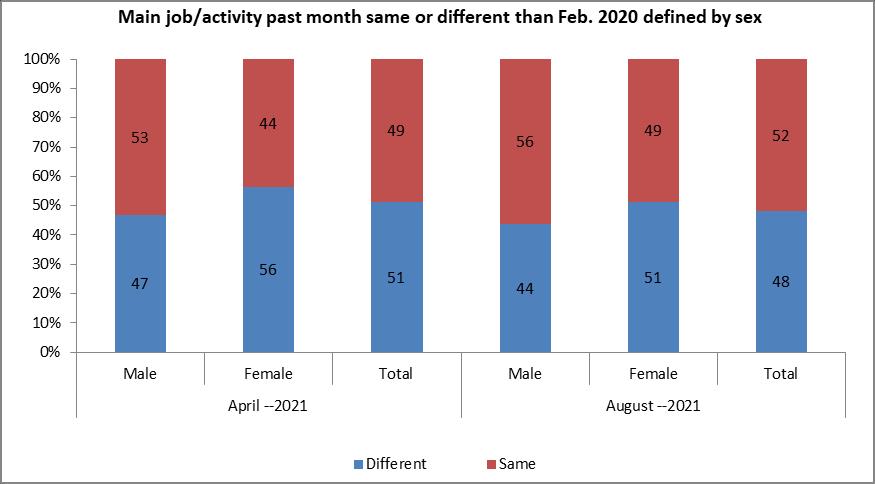
9 minute read
unemployment, wages and hours defined by occupations and initial sector of economic activity
4.2. Change in employment, unemployment, wages and hours defined by occupations and initial sector of economic activity
The analysis using the ERF COVID MENA Monitor Sudan Survey data (2021) show that the majority and nearly half of all households (51%, 48%), nearly half of males (47%, 44%) and more than half of females (56%, 51%) indicate that the main job/activity in the past month is different than February 2020, while nearly half of all households (49%, 52%), more than half of males (53%, 56%), and nearly half of females (44%, 49%) indicate that the main job/activity in the past month is the same as that of February 2020 as indicated by the respondents to the first wave (April 2021) and second wave (August 2021) respectively. (See Figure 5). This implies transitions in the main job/economic activity from the pre Covid-19 pandemic period and during the COVID-19 pandemic period. For instance, the analysis using the first wave ERF COVID MENA Monitor Sudan Survey data (2021) show the change in employment, unemployment, wages and hours defined by occupations and initial sector of economic activity. Regarding employment between April 2021 and August 2021, the employment rate according to initial sector of economic activity decreased for some sectors of economic activity including agriculture, fishing or mining, and health sector, while the employment rate improved for other sectors of economic activity including the manufacturing, construction or utilities, retail or wholesale, transportation and storage, accommodation and food services, information and communication, financial activities or real estate, education and other services. The employment rate according to occupations decreased for manager/professional occupation, while the employment rate improved for other occupations including the technicians/associate professionals, clerks/service workers, and blue collar, skilled agricultural, production and transport. (See Figures 6-7)17
Concerning the unemployment rate, between April 2021 and August 2021 the unemployment rate according to initial sector of economic activity (according to the standard definition) remained the same for the agriculture, fishing or mining, but decreased for some sectors of economic activities including construction or utilities, retail or wholesale, information and communication, financial activities or real estate, education and other services, but increased for other sectors of economic activities including manufacturing, transportation and storage, accommodation and food services, and health sector. The unemployment rate according to initial sector of economic activity (according to the broad definition) decreased for construction or utilities, retail or wholesale, transportation and storage, information and communication, financial activities or real estate, education and other services, but increased for other sectors of economic activity including the agriculture, fishing or mining, manufacturing, accommodation and food services, and health sector. The unemployment rate according to occupations (according to the standard definition) increased for manager/ professional occupation, but decreased for other occupations including the technicians/associate professionals, clerks/service workers, and blue collar, skilled agricultural, production and transport. While, the unemployment rate (according to the broad definition) decreased for all occupations including the manager/professional, technicians/associate professionals, clerks/service workers, and blue-collar, skilled agricultural, production and transport. (See Figures 6-7)
Regarding wages, between April 2021 and August, the personal net monthly wages (SDG 15,000 or more net monthly wage in the past month in 2021) according to initial sectors of economic activity increased for some sectors including accommodation and food services, information and communication, financial activities or real estate, education, and health, while, the personal net monthly wage (SDG 15,000 or more net monthly wage in the past month in 2021) decreased for other sectors including agriculture, fishing or mining, manufacturing, construction or utilities, retail or wholesale, transportation
17We are aware that it would be interesting to add analysis according to classification of employment in formal jobs and informal jobs. However, the lack of adequate data on formal and informal jobs and income and employment conditions constrained our paperto consider analysis of income and work conditions according to formal jobs/ informal jobs. We hope to consider this interesting topic in our future research when adequate data on classification according to formal jobs and informal jobs are available.
and storage, and other services. The personal net monthly wage (SDG 15,000 or more net monthly wage in the past month in 2021) according to occupations decreased for all occupations. While, the personal net monthly wage (SDG 10,000-less than SDG 15,000 net monthly wage in the past month in 2021) increased for blue collar, skilled agricultural, production and transport, but decreased for all other occupations including manager/professional, technicians/associate professionals, and clerks/service workers. (See Figures 6-7)
Concerning hours, between April 2021and August 2021 the number of working hours (90 or more working hours in the past seven days) according to initial sector of economic activity increased for some sectors including agriculture, fishing or mining, manufacturing, construction or utilities, retail or wholesale, information and communication, financial activities or real estate, health, and other services, while, the number of working hours (less than 30 working hours in the past seven days) decreased for some sectors including transportation and storage, accommodation and food services, and education sectors. The number of working hours (less than 30 working hours in the past seven days) according to occupations increased for all occupations including manager/professional, technicians/associate professionals, clerks/service workers, and blue-collar, skilled agricultural, production and transport. (See Figures 6-7)
Figure 5-Change in main job/activity in the past month and job formality (socail insurance for wage workers)
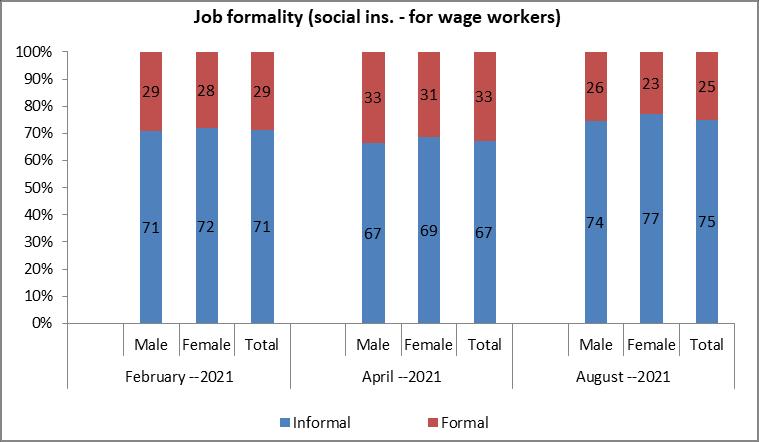
Source: Author own calculation based on ERF COVID MENA Monitor Survey data: COVID-19 Monitor Sudan HH (April 2021-August 2021)
Figure 6–Change in employment, unemployment, wages and hours defined by initial sector of economic activity classification (April-August 2021)

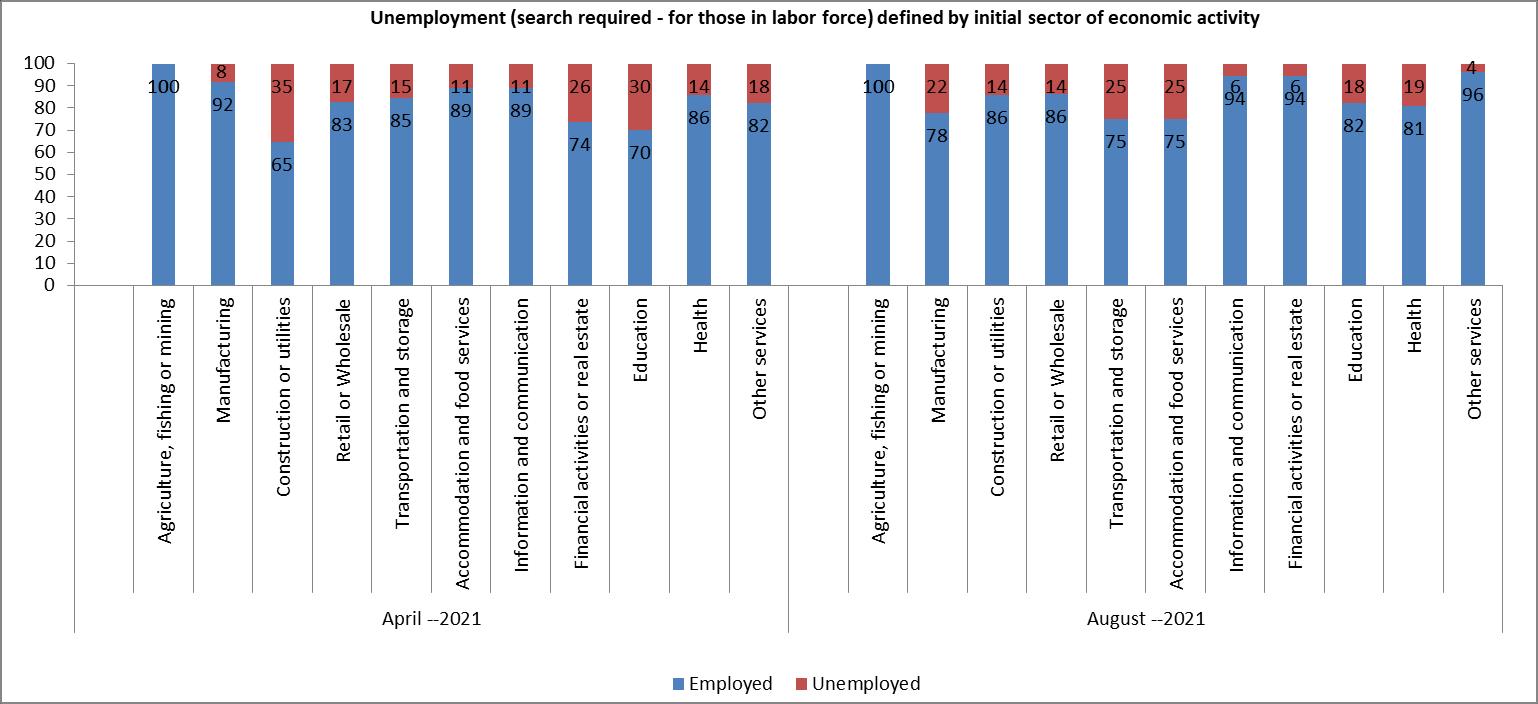
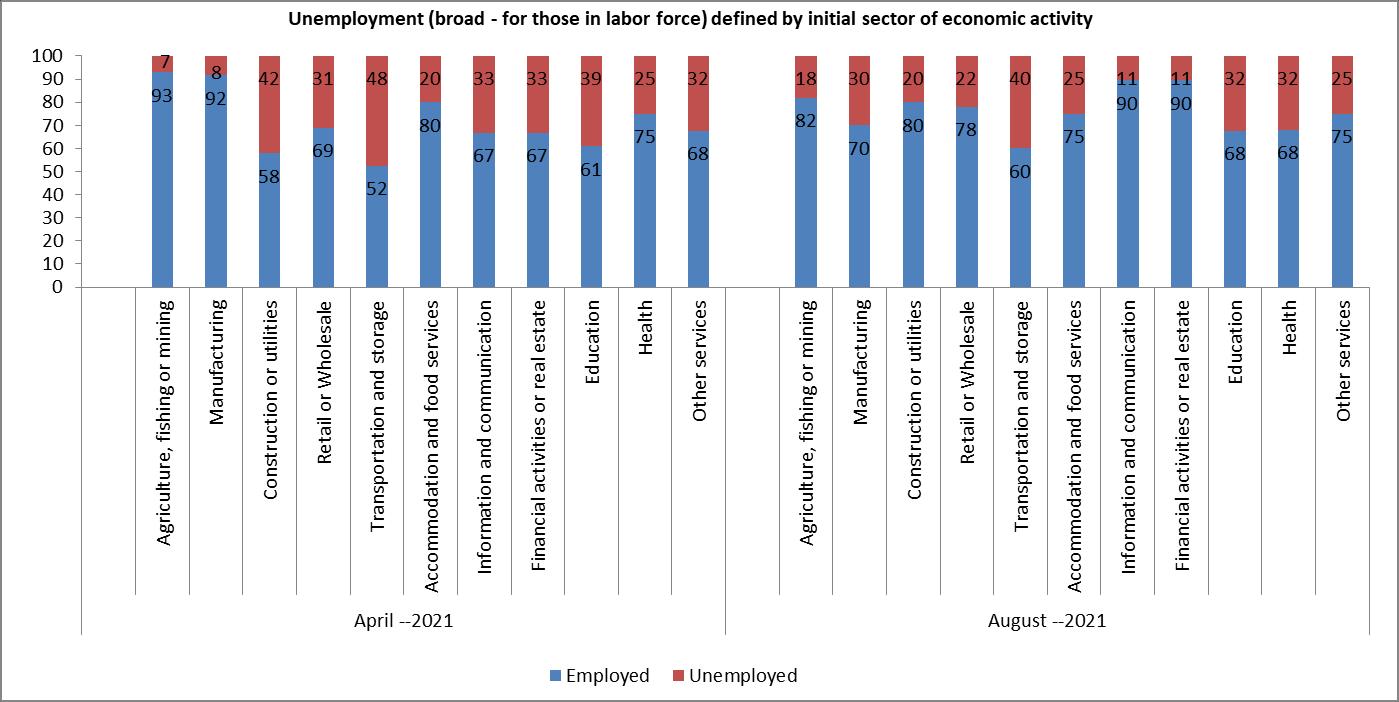
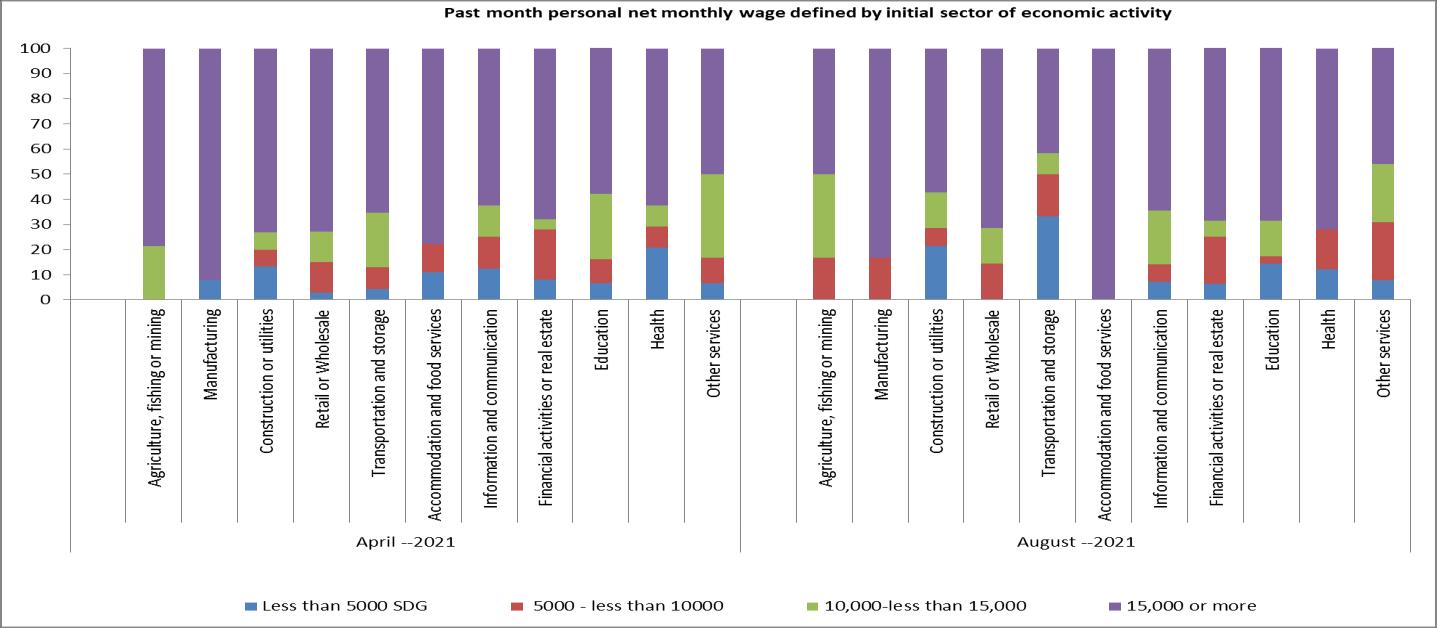
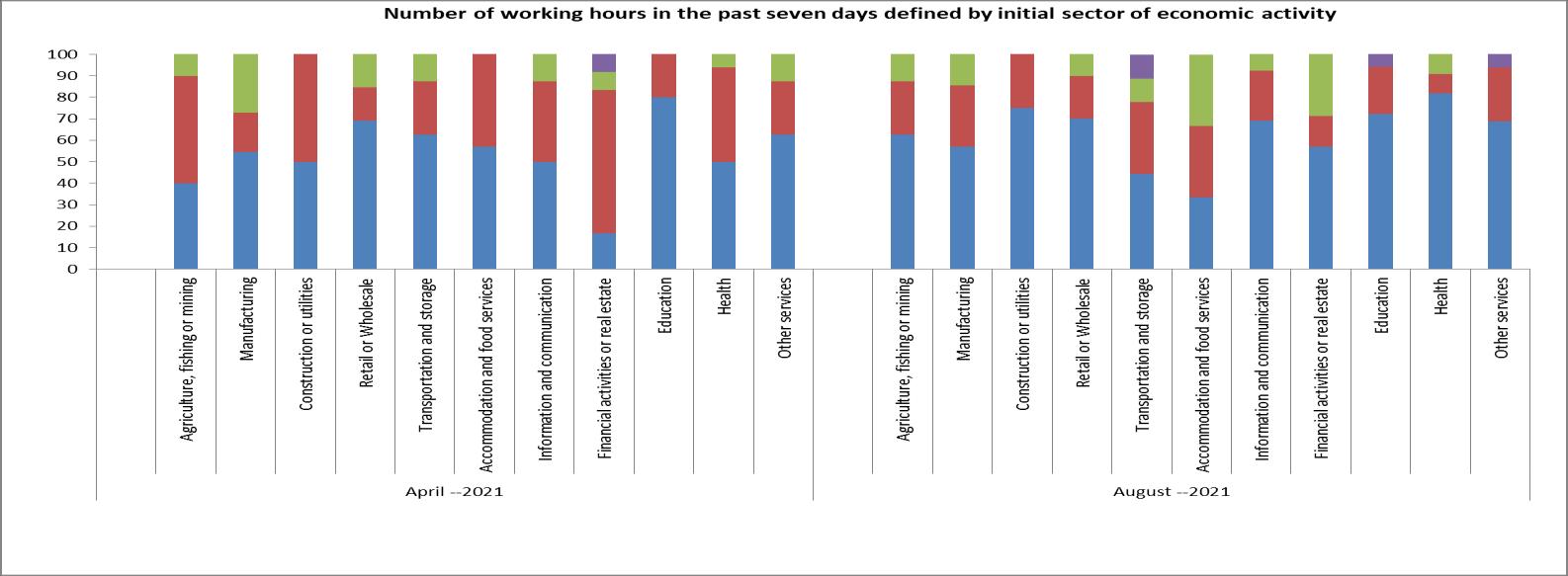
Source: Author own calculation based on ERF COVID MENA Monitor Survey data: COVID-19 Monitor Sudan HH (April 2021-August 2021)
Figure 7 –Change in employment, unemployment, wages and hours defined by occupa classification (April-August 2021)
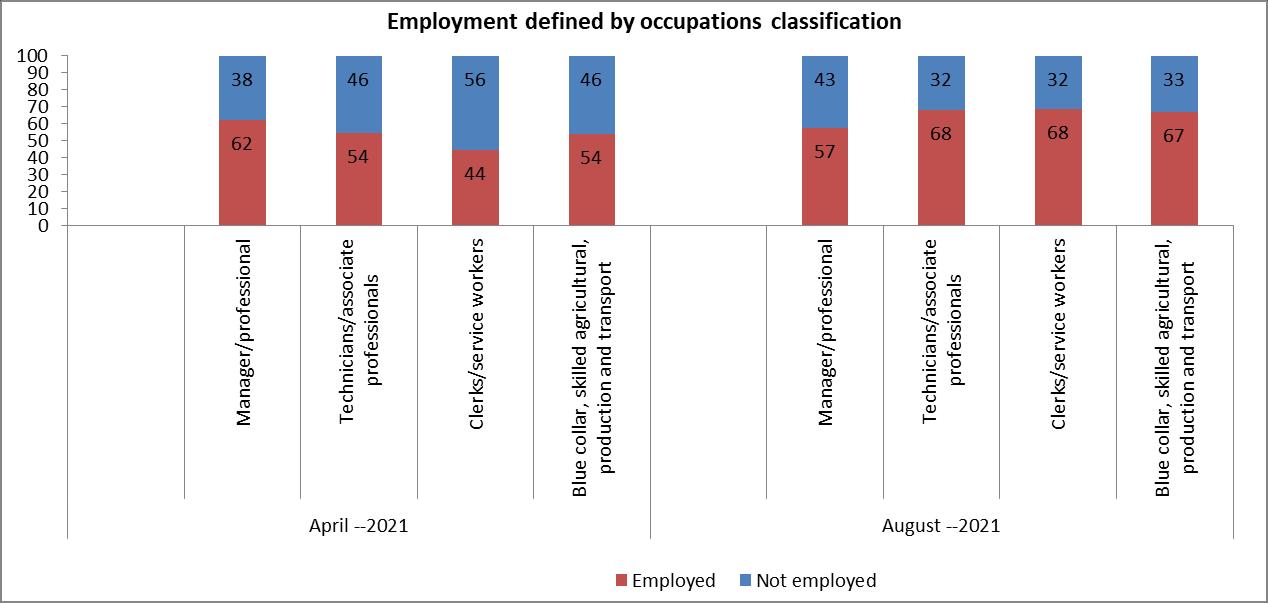
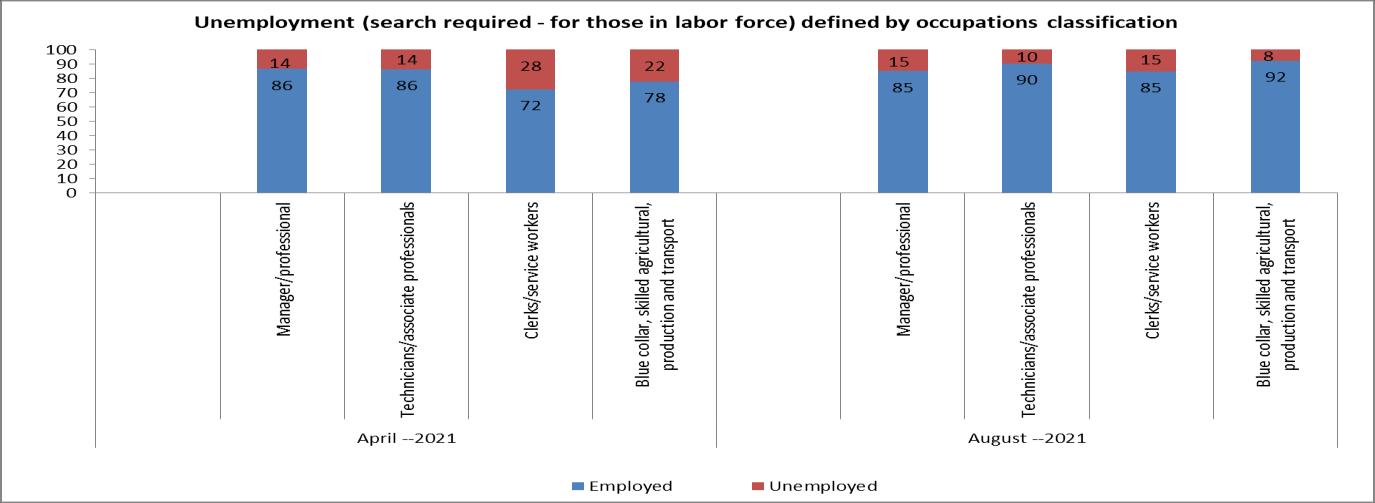
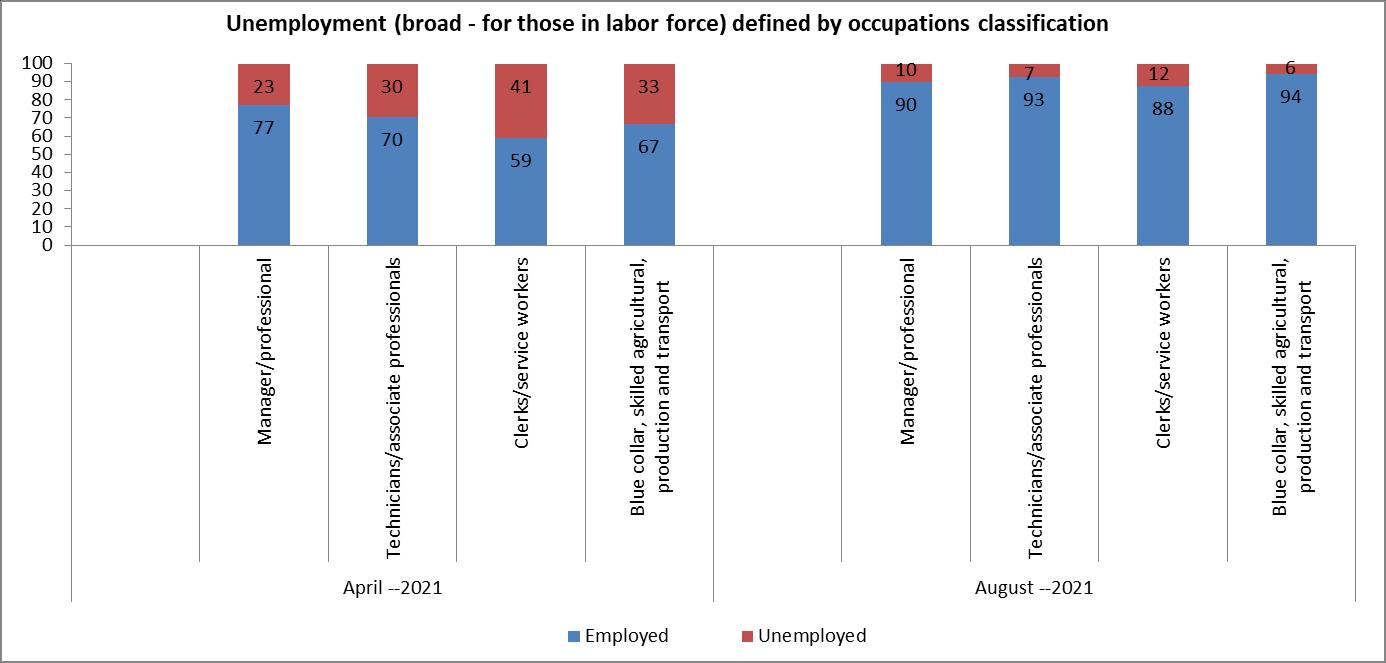
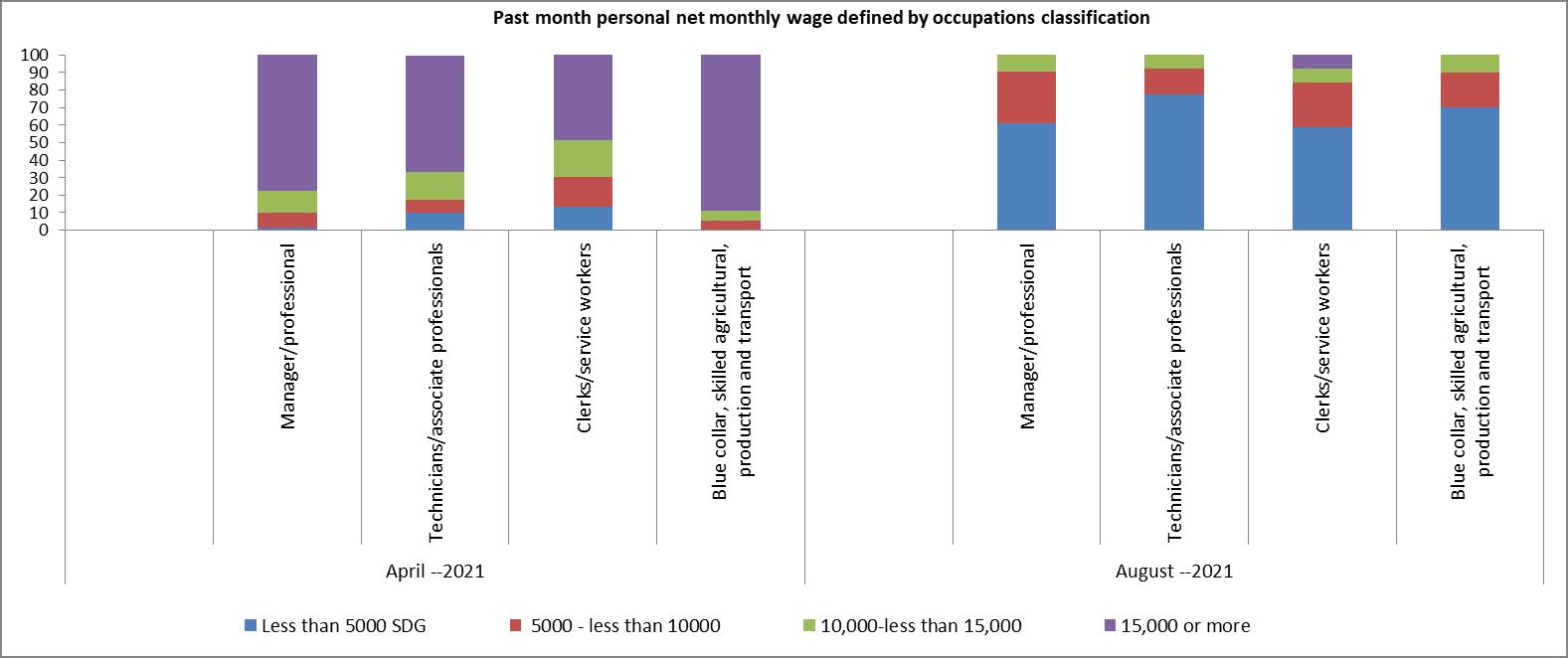
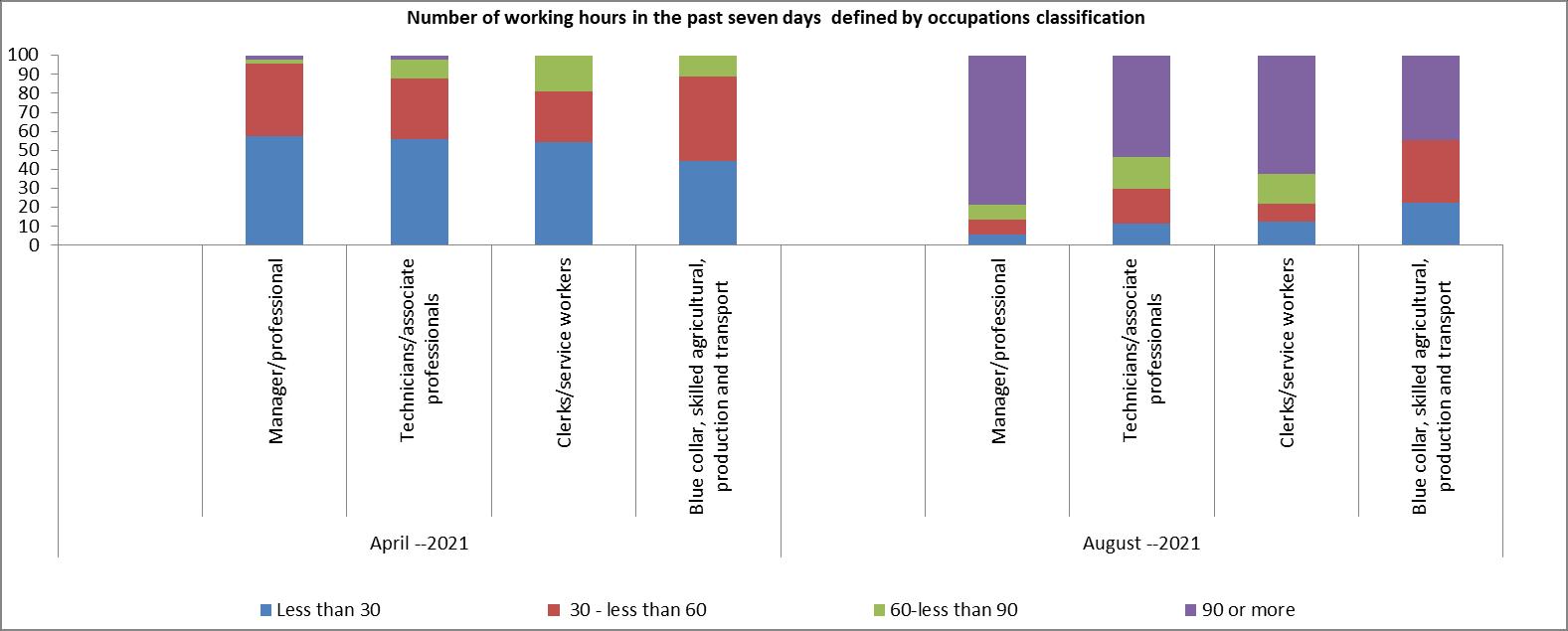
Source: Author own calculation based on ERF COVID MENA Monitor Survey data: COVID-19 Monitor Sudan HH (April 2021-August 2021)
In addition, the distribution of employment by sector of economic activity (April 2021) that implies that the majority of all households are working on Retail or Wholesale (16%), followed by other services (14%), Education (12%), Health (10%), Financial activities or real estate (10%), Transportation and storage (9%), Construction or utilities (8%), Agriculture, fishing or mining (6%), Manufacturing (6%), Information and communication (5%), and Accommodation and food services (4%) respectively. In addition, the analysis using the second wave ERF COVID MENA Monitor Sudan Survey data (2021) show the distribution of employment by sector of economic activity (August 2021) implies that the majority of all households are working on Education (20%), followed by other services (19%), Retail or Wholesale (13%), Transportation and storage (13%), Construction or utilities (8%), Health (6%), Financial activities or real estate (6%), Agriculture, fishing or mining (6%), Manufacturing (5%), Information and communication (4%), and Accommodation and food services (1%) respectively. In addition, the analysis using the World Bank and Sudan households COVID-19 Survey data (2020) show the sector of the work left (the main activity of the business or organization in which households were working in their main job before March 2020 (i.e. before the COVID-19 pandemic period). The majority and nearly a quarter of households left the work at the buying and selling goods sector repair of goods, hotels & restaurants (23%), while nearly fifth of household left the work at the agriculture, hunting, fishing (19%), personal services, education, health, culture, sport, domestic work, and other (18%). Whereas, few and less than tenth of household left the work at construction (8%), professional activities: finance, legal, analysis, computer, real estate (4%), transport, driving, post, travel agencies (4%), mining, manufacturing (3%), public administration (2%), electricity, gas, water supply (1%), and other.
The main reasons for changing jobs for the majority and nearly half of households and the household head because business/ gov’t closed due to coronavirus legal restrictions (and/or for another reason) for households (44%) and household head (48%), followed by not able to go to farm due to movement restrictions and/ or due to lack of inputs for household (3%) and household head (5%), not farming season for household (1%) and household head (5%). laid off while business continues (1%), other for household (16%) and household head (19%), seasonal worker for household (23%) and household head (19%), temporarily absent (7%), vacation for household (3%) and household head (5%), and reduction in staff due to less business (1%) respectively. The main reasons for changing job varies according to gender, for instance, for males the main reasons for changing jobs for the majority and nearly half of males because business/ gov’t closed due to coronavirus legal restrictions (and/or for another reason) (41%), followed by not able to go to farm due to movement restrictions and/ or due to lack of inputs (3%), not farming season (3%), laid off while business continues (1%), other (17%%), seasonal worker (25%), temporarily absent (7%), vacation (2%), and reduction in staff due to less business (2%) respectively. while, for females the main reasons for changing jobs for the majority and nearly three quarter of females because business/ gov’t closed due to coronavirus legal restrictions (and/or for another reason) (70%), followed by seasonal worker (10%), temporarily absent (10%), and vacation (10%) respectively. The Change in jobs and reasons for changing jobs during the COVID-19 pandemic period for household and household head vary across regions/states in Sudan.
The analysis using the ERF COVID MENA Monitor Sudan Survey data (2021) show the structure of labour market according to job formality defined according to social insurance for wage workers in February 2020 that implies that the majority and more than two thirds of all households (67%, 75%), males (67%, 74%) and females (69%, 77%) are working in informal jobs, compared to less than third of all households (33, 25%%), males (33%, 26%), and females (31%, 23%) working in formal job, working in informal jobs for females are higher than males, betweenApril 2021 and August 2021 the work in the increase in informal job increased for female is higher than male, as indicated by the respondents to the first wave (April 2021) and second wave (August 2021) respectively. (See Figure 8)






